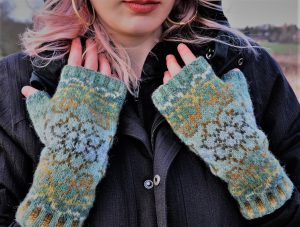Gloves are important for many activities because they keep your hands warm, give you a better grip, and protect your hands. Gloves can be put into two groups: those with full fingers and those without. Fingerless gloves, as their name suggests, only cover the wrist and palm area, leaving the fingers and thumb uncovered.
Full-finger gloves, on the other hand, cover the whole hand, including the fingers. Generally speaking, full-finger gloves provide more comprehensive protection while fingerless gloves offer more dexterity/grip but it also depends on the activity and the situation.
Benefits of Fingerless Gloves
Fingerless gloves have a lot of advantages over full-finger gloves. One of the most important benefits is that it offers flexibility and dexterity. Fingerless gloves are generally ideal for precise and accurate tasks like typing, driving, and weightlifting because they give the fingers more room to move.

Some common materials used to make fingerless gloves include knit, leather, neoprene, etc. Knit fingerless gloves are soft and let air in, which makes them great for everyday use. Leather fingerless gloves, on the other hand, offer better grip, protection, and longer durability.
Read on if you want to how to make fingerless gloves is made
Benefits of Full Finger Gloves
When climbing, gardening, cycling/motorcycling, or skiing, full-finger gloves are generally better than fingerless gloves because they can protect and warm your hands better. You can find them in different materials, like leather, synthetics, and thermal textiles, so you can choose the best pair for your activities.

One of the most important things about full-finger gloves is that they can keep your hands warm and out of the cold. Even when you’re in the best work gloves for cold weather, your hands will stay warm and dry because some full-finger gloves are made with thermal textiles that work as insulation while still allowing air to flow out. Fingerless gloves don’t have insulating properties as they expose your fingers instead.
Choosing the Right Gloves
It’s important to choose the right gloves for each task and situation to make sure performance, safety, and comfort. When looking for the right gloves, there are a few things to keep in mind to make sure you get the right fit and protection for the activities you’ll be doing.
1. Fit
Fit is one of the most important things to think about when choosing gloves. Gloves that are too tight can be uncomfortable and cut off your circulation, while gloves that are too loose might make it hard to move your hands, making it hard to do things. Look for gloves that fit snugly but still let you move your fingers.
2. Material
The material of the gloves will have a big effect on how well they work for a certain task. For example, leather gloves are great for hard jobs like construction, but they might not be the best choice for outdoor activities as they’re not breathable. For sports and activities outside, synthetic fabrics like polyester and spandex can be more flexible and better at getting rid of sweat.
3. Activity level
The gloves you should choose should depend on the intensity and activities you’d do. If you want to keep your hands safe and comfortable while doing a hard sport, like rock climbing or skiing, you will need gloves that offer enough protection and warmth. For lower-intensity activities that require more accuracy and precision, you would want gloves that give you more flexibility and dexterity.
By carefully considering these things, you can choose gloves that are best for your needs and make sure you get the performance, protection, and comfort you need for the activity you want to do.
Pros and Cons of Fingerless Gloves and Full-Finger Gloves
There are pros and cons to both gloves with and without fingers. Fingerless gloves can give you more flexibility and dexterity but less warmth and protection, while full-finger gloves provide more warmth and protection but less flexibility and dexterity.
Here is a comparison table to help you choose the best gloves for your specific needs:
| Factors | Full Finger Gloves | Fingerless Gloves |
| Dexterity | Limited | Good |
| Flexibility | Limited | Good |
| Protection | Comprehensive, Full Finger Coverage | Partial, Half-finger |
| Precision | Limited | Supported |
| Warmth | Good, with insulation | Poor, with fingers exposed |
| Breathability | Limited | Full, especially on fingers. |
| Activities | Outdoor activities: climbing, biking, skiing, etc | Indoor activities: weightlifting, typing, driving, etc |
| Materials | Thermal fabrics, leather, kevlar, synthetic | Leather, Neoprene, Knit |
| Fit | Snug Fit, Tight Fit | Snug Fit, Tight Fit |
Frequently Asked Questions about Fingerless Gloves and Full Finger Gloves
What is the toughest material for gloves?
Most people agree that goatskin is the strongest and most durable type of leather. The natural lanolin in the skin makes the glove very soft, waterproof, and resistant to wear.
Can you wear fingerless gloves in cold weather?
In very cold weather, fingerless gloves are not a good idea because they don’t keep your fingers warm. But you can wear them in moderately cold weather if they are made of thicker materials like wool or neoprene.
Which materials make the best full-finger gloves?
The best materials for full-finger gloves depend on what you’ll be doing and the weather. In cold weather, you should wear clothes that keep you warm. For activities that require grip or dexterity, synthetic materials like nylon or spandex are recommended
What material has the best grip?
Silicone is often used because it can keep things from slipping. It can be used as a material for gloves and other things that need to grip and not slip. But when it comes to gloves, there are many materials that have good grips, such as neoprene, latex, etc.
Are full-finger gloves waterproof?
Not all full-finger gloves are made of waterproof materials, but some are. These gloves are great for things to do that involve water. Check the gloves’ technical specifications to see if they are waterproof.
Conclusion
Fingerless gloves and full-finger gloves are good for different things. Fingerless gloves make it easier to do things that need more dexterity, flexibility, and accuracy. On the other hand, full-finger gloves keep your hands warm and help you grip things when you’re outside in cold weather. When buying gloves, think about the fit, the material, and the activity level. Full-finger gloves are great for keeping your hands warm and safe, while fingerless gloves are better for moving your fingers. In the end, the best gloves depend on what each person needs and would do.

I am not a good blogger but I started blogging when I was in my college. one day scrolling my social media pages and top of the page one notification was coming like this “ earn money from blogging”.then I clicked that notification. After that, I was confused that which niche is better for me. Finally, I selected the niche and I was comfortable with that glove’s reviewer.

